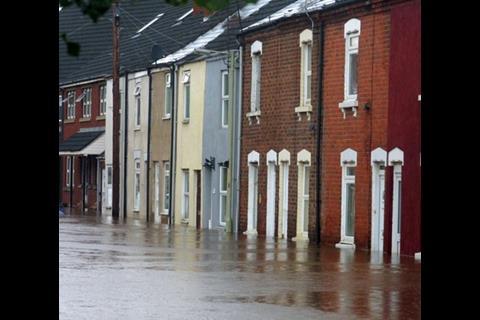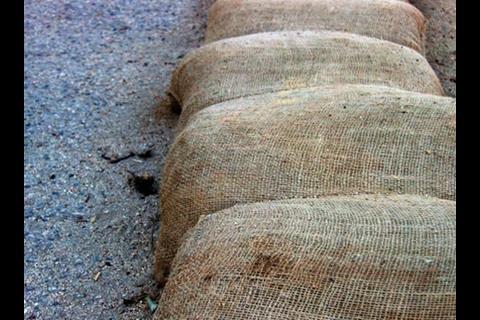As water levels and flood risks rise across the country, Peter Caplehorn of Scott Brownrigg offers some guidance to specifiers trying to protect doors and windows
Recent events have made it painfully clear that flooding is becoming a big problem. On both new-build and refurbishment projects, designers and specifiers must advise clients on measures that can be taken to limit serious damage if flooding occurs.
Blocking large openings is one of the first lines of defence so specifiers should look at making doors and windows more resistant to water penetration. There are a number of products available that are easier to use than sandbags, yet work just as well.
Many of these products take the form of boards that slide into place across the lower parts of doors or windows. For some of these products, the opening must be prepared with brackets or fixings and a frame that will provide the primary water seal. The board, made from metal, plastic or a composite, can then be easily fixed into place.
Basic considerations
Research shows that water of more than a metre in depth can result in structural damage to the average construction. Below this, however, it is possible to limit the water flow, minimising the damage and time taken to get the building back to normal.
The designer should also be aware of the performance of the surrounding fabric, services connections and finishes. Small openings such as air bricks or service penetrations need to be considered at the same time as doors and windows and treated in the same way. Non-return valves on the drainage system and flood-resilient building finishes need to be looked at, too.
Designers and specifiers should also consider the potential direction of water flow. Preventing freeflowing water reduces the amount of debris and rubbish that can enter the building, as well as minimising the impact on fixtures and fittings.
It should then be made clear to the client that these are mitigation measures only.
Standards and guidance
For several years, a Kitemark scheme (PAS 1188-1 and 2) has been in place to identify the parameters and performance of these devices. The standard recognises that any barrier will not prevent water from entering a building completely. Insurers may well insist on the inclusion of Kitemarks as part of future policy conditions in areas of risk.
Guidance on identifying risk and the measures that can be put in place is available from a number of sources. The Environment Agency publishes useful
guides in conjunction with CIRIA, BSI and HR Wallingford, where most of the testing is undertaken. See references below.
Types of system
Devices for fitting directly to doors and windows and devices that act as barriers around the building are available.
There are also valves that can be fitted to drains and covers for smaller openings.
For new builds, there are products that consist of barriers at doors and windows and a secondary barrier around the building.
Several systems use fabric or membranes supported by a panel structure, rather than rigid panels. These are less durable, as they can be easily damaged by floating debris.
The specifier should also be aware that systems must offer some degree of security enhancement as buildings may be empty until floodwaters recede. Systems that lock in place and can only be removed by the building owner are advisable.
The designer should also consider the appearance of the framing system as these will be permanently fixed.
Products
These are some of the flood protection products available:
- Floodgate is a panel system that works without permanent fixing to the property. The panels can be used individually on smaller openings or joined together to protect larger openings such as factory doors
- Floodguard offers a range of flood-proof doors with a pneumatic seal around the perimeter that inflates when a sensor detects rising water. The company also makes a panel system and products to protect smaller openings such as airbricks
- Bauer Inner City has systems for commercial applications. The product consists of a permanent frame around the opening and a series of aluminium panels slotted into it. Bauer also makes a barrier system to surround a property
- Geodesign makes Aqua Barrier, which uses commercial pallets as the basic barrier that surrounds a building. These are mounted on purpose-made brackets at an angle and a waterproofing sheet is laid on top. An effective barrier up to 1m deep can be constructed from a single line of pallets if the ground conditions are straightforward.
Care should be exercised by the specifier as there is no easy way to check these products are correctly installed – and they need to work first time.
Points to remember
- Give the client a clear assessment of the measures required
- Barriers will not make the building watertight
- This is a risk mitigation exercise
- Consider integrated framing, storage of panels and easy deployment
- Do not consider protection over 1m without structural advice.
Postscript
References
For more information and the Environment Agency booklets Damage Limitation and Flood Products, go to www.environment-agency.gov.uk and click on “Flood”.
Topics
Specifier 07 September 2007

- 1
- 2
- 3
- 4
- 5
- 6
- 7
- 8
- 9
- 10
- 11
- 12
- 13
- 14
 Currently
reading
Currently
reading
What to remember: Flood proofing







































No comments yet